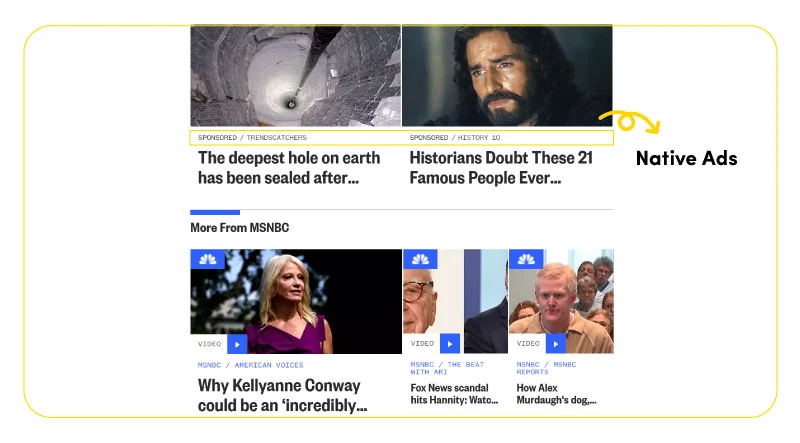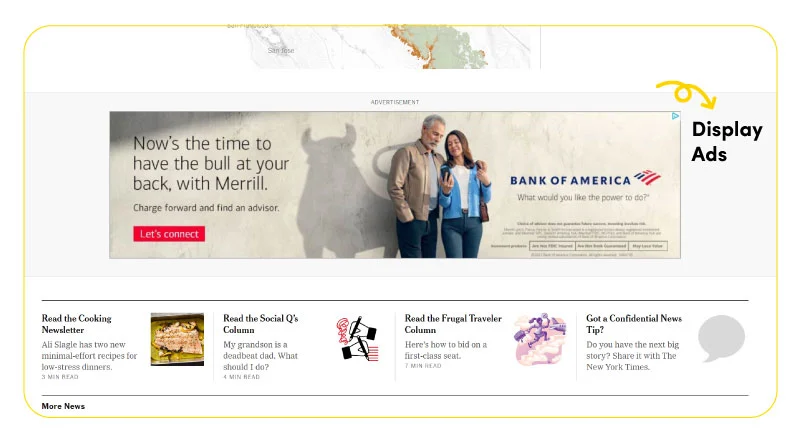In today’s digital landscape, businesses have a wide array of options for advertising their products and services. Two popular types of online advertising are native ads and display ads. While both types of ads can be effective, they differ in key ways that can impact their success. Understanding the difference between native and display ads is essential for businesses looking to launch successful advertising campaigns.

By understanding the unique strengths and weaknesses of each type of ad, businesses can choose the right format for their marketing goals and effectively reach their target audience. In the following sections, we’ll explore the differences between native and display ads in more detail and offer insights into when each type of ad is most effective.
| Benefits | Native Ads | Display Ads |
|---|---|---|
| Higher Engagement | ✔️ | ❌ |
| Improved User Experience | ✔️ | ❌ |
| Increased Credibility | ✔️ | ❌ |
| Higher Conversion Rates | ✔️ | ❌ |
| Greater Visibility | ❌ | ✔️ |
| Wide Reach | ❌ | ✔️ |
| Creative Flexibility | ❌ | ✔️ |
| Targeting Options | ❌ | ✔️ |
Native Ads
Native ads are a type of advertising that is designed to fit in with the form and function of the platform or website where they appear. They are often created to blend seamlessly with the content around them and provide a non-disruptive advertising experience. Native ads are becoming increasingly popular in digital advertising due to their effectiveness in engaging users.
Definition and Characteristics of Native Ads
Native ads are created to appear as a natural part of the user experience and are often not immediately recognizable as ads. They can appear in a variety of formats, including sponsored content, in-feed ads, and promoted listings. There are several dedicated and highly popular native ads platforms like Taboola and Outbrain that serve millions of native ads across large networks of websites and apps.

One of the key characteristics of native ads is that they are non-disruptive, which means that they do not interrupt the user experience. Instead, they aim to blend in with the content and provide a seamless experience for the user. This makes them more appealing to users, which in turn can increase engagement rates.
Examples of Native Ads
Native advertising examples can be found on many popular websites and social media platforms. For instance, Facebook’s sponsored posts, Instagram’s sponsored stories, and Twitter’s promoted tweets are all examples of native ads.

Another example is BuzzFeed‘s sponsored content, which blends seamlessly with their listicle-style articles.
Advantages and Disadvantages of Native Ads
One of the main advantages of native ads is their non-disruptive nature. By blending in with the content, native ads can provide a more natural and less intrusive advertising experience for users. Additionally, native ads are often more effective at engaging users, as they are designed to match the look and feel of the platform where they are displayed.

However, one of the disadvantages of native ads is that they can be difficult to identify as ads. This can lead to users clicking on them without realizing that they are sponsored content, which can be seen as deceptive. Additionally, creating effective native ads requires a high degree of creativity and skill, which can make them more difficult and time-consuming to produce than other types of ads.
Display Ads
Display ads are visual ads that appear on websites, apps, or social media platforms. They are often in the form of banners, videos, images, or interactive media. Display ads are usually placed in strategic locations on web pages and apps to increase visibility and attract user attention.
Definition and Characteristics of Display Ads
Display ads are a type of online advertising that is designed to visually promote a brand, product, or service. They are typically placed on websites and other digital platforms that the target audience is likely to visit. Display ads can be static or dynamic, and they can feature a variety of media types, including images, videos, and animations.

They are usually clickable, and when users click on them, they are taken to a landing page where they can learn more about the advertised product or service.
Examples of Display Ads
Display ads can take many forms, including banners, videos, and interactive ads. Some examples of display ads include:
- Banner ads: These are rectangular ads that appear at the top, bottom, or sides of a web page.
- Video ads: These are ads that play automatically or on user clicks and can appear on websites or social media platforms.
- Interactive ads: These are ads that allow users to engage with the content by playing a game, taking a quiz, or filling out a form.

Advantages and Disadvantages of Display Ads
Advantages of display ads include:
- Increased brand awareness: Display ads can increase brand visibility and recognition by placing the brand in front of a large audience.
- Targeted advertising: Display ads can be targeted to specific audiences based on demographics, interests, and online behavior.
- Measurable results: Display ads can be tracked and measured using analytics tools to determine their effectiveness and ROI.
Disadvantages of display ads include:
- Ad blindness: Users may ignore or become immune to display ads due to their abundance and repetition.
- Ad blockers: Users may install ad-blocking software to prevent display ads from appearing.
- Click fraud: Some unethical advertisers may engage in click fraud to artificially inflate the number of clicks on their ads.

Understanding the characteristics, advantages, and disadvantages of display ads can help marketers make informed decisions about their advertising strategies.
Comparing Native ads and Display ads
Native ads and display ads are both effective advertising strategies, but they have distinct differences. In this section, we will compare the two types of ads in terms of format, appearance, user engagement, advertising goals, target audiences, and real-world examples.
Format, Appearance, and User Engagement
Native ads are designed to blend in with the content of the website or platform they are displayed on. They have a seamless appearance and are often presented in the form of sponsored articles, videos, or social media posts. Native ads tend to have higher user engagement as they appear more relevant and interesting to the user.

Display ads, on the other hand, are typically banner or pop-up ads that appear at the top or sides of a website or within an app. They are designed to catch the user’s attention through eye-catching graphics, animation, and other visual effects. Display ads tend to have lower user engagement as they are often viewed as intrusive or annoying.
Advertising Goals and Target Audiences
Native ads are best suited for increasing brand awareness, building trust, and providing valuable content to the user. They are often used to target specific audiences based on their interests, behaviors, or demographics.
Display ads, on the other hand, are best suited for promoting products or services, driving sales, and increasing website traffic. They are often used to target broader audiences based on their location, search history, or other factors.
Advertising Goals and Target Audiences
Some successful campaigns that used native ads include the “The Women’s Running Magazine Women’s Half Marathon” campaign by REI, which used sponsored articles and social media posts to promote a women’s half marathon event, and the “Our Food. Your Questions.” campaign by McDonald’s, which used sponsored articles and videos to answer questions about the company’s food.
Some successful campaigns that used display ads include the “Just Do It” campaign by Nike, which used banner ads to promote their products and encourage users to visit their website, and the “Get a Mac” campaign by Apple, which used pop-up ads to promote their Mac computers and highlight the disadvantages of Windows computers.
Conclusion
In conclusion, both native ads and display ads have their own unique strengths and weaknesses. The choice between the two types of ads ultimately depends on the advertising goals and target audience. By understanding the differences between the two, advertisers can choose the right ad format for their campaign and maximize their advertising ROI.
FAQs
What is the main difference between native ads and display ads?
The main difference between native ads and display ads is their format and appearance. Native ads are designed to blend in with the content of the website or app they appear on, while display ads are more visually distinct and typically appear in standard sizes and formats.
Can display ads be made to look like native ads?
Display ads can be made to look like native ads, but it is important to ensure that they are clearly labeled as ads to comply with advertising guidelines and regulations.
Are native ads more expensive to run than display ads?
The cost of running native ads versus display ads can vary depending on factors such as the platform, targeting options, and ad format. In general, native ads may be more expensive due to their customized format and the additional effort required to create them.







 Facebook Ads Spy Tool
Facebook Ads Spy Tool TikTok Ads Spy Tool
TikTok Ads Spy Tool